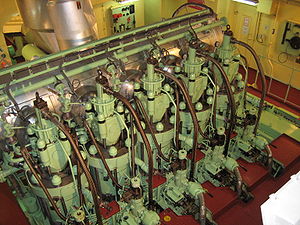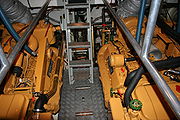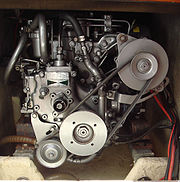
Inboard motor
Encyclopedia

Marine (ocean)
Marine is an umbrella term. As an adjective it is usually applicable to things relating to the sea or ocean, such as marine biology, marine ecology and marine geology...
propulsion system for boat
Boat
A boat is a watercraft of any size designed to float or plane, to provide passage across water. Usually this water will be inland or in protected coastal areas. However, boats such as the whaleboat were designed to be operated from a ship in an offshore environment. In naval terms, a boat is a...
s. As opposed to an outboard motor
Outboard motor
An outboard motor is a propulsion system for boats, consisting of a self-contained unit that includes engine, gearbox and propeller or jet drive, designed to be affixed to the outside of the transom and are the most common motorized method of propelling small watercraft...
where an engine is mounted outside of the hull
Hull (watercraft)
A hull is the watertight body of a ship or boat. Above the hull is the superstructure and/or deckhouse, where present. The line where the hull meets the water surface is called the waterline.The structure of the hull varies depending on the vessel type...
of the craft, an inboard motor is an engine
Engine
An engine or motor is a machine designed to convert energy into useful mechanical motion. Heat engines, including internal combustion engines and external combustion engines burn a fuel to create heat which is then used to create motion...
enclosed within the hull
Hull (watercraft)
A hull is the watertight body of a ship or boat. Above the hull is the superstructure and/or deckhouse, where present. The line where the hull meets the water surface is called the waterline.The structure of the hull varies depending on the vessel type...
of the boat
Boat
A boat is a watercraft of any size designed to float or plane, to provide passage across water. Usually this water will be inland or in protected coastal areas. However, boats such as the whaleboat were designed to be operated from a ship in an offshore environment. In naval terms, a boat is a...
, usually connected to a propulsion screw
Propeller
A propeller is a type of fan that transmits power by converting rotational motion into thrust. A pressure difference is produced between the forward and rear surfaces of the airfoil-shaped blade, and a fluid is accelerated behind the blade. Propeller dynamics can be modeled by both Bernoulli's...
by a
driveshaft
Driveshaft
A drive shaft, driveshaft, driving shaft, propeller shaft, or Cardan shaft is a mechanical component for transmitting torque and rotation, usually used to connect other components of a drive train that cannot be connected directly because of distance or the need to allow for relative movement...
.
History

Charlotte Dundas
The Charlotte Dundas is regarded as the world's "first practical steamboat", the first towing steamboat and the boat that demonstrated the practicality of steam power for ships....
. Harbour tugs, and small steam launches had
inboard steam engines. In the 1880s the naphtha engine made its appearance and a few boat engines appeared. They were dangerous and difficult to run.
The gas engine pioneer Gottlieb Daimler
Daimler
- Daimler with reference to motor vehicles :refers to:* Gottlieb Daimler , German automobile inventor- Business co-founded by Gottlieb Daimler :...
and Maybach built a four-cycle boat engine and tested it in 1887 on the Neckar River. Sintz in America built several commercially available engines from 1893. About 1895 the inboard oil engine emerged for small boats. From this hundreds of small boat engine manufactures set up shop: Bolinder, Gray Marine Engine
Gray Marine Engine
Gray Marine Motor Company was an important marine engine builder. It built gasoline engines ranging from one to six cylinders in both gas and later diesel layouts which were used in pleasure and work boats....
, Kermath, Union Iron Works
Union Iron Works
Union Iron Works, located in San Francisco, California, on the southeast waterfront, was a central business within the large industrial zone of Potrero Point, for four decades at the end of the nineteenth and beginning of the twentieth centuries.-History:...
, Caille, Palmer, Red Wing, St. Lawrence, and Buda; Sulzer, B and W, Gardner, and Ailsa Craig to mention a few. Two-cycle engines were popular for many years, however, the parallel development of the auto engine, with their many cylinders, became a natural transposition. Chrysler, Ford, Packard
Packard
Packard was an American luxury-type automobile marque built by the Packard Motor Car Company of Detroit, Michigan, and later by the Studebaker-Packard Corporation of South Bend, Indiana...
, and Hudson also made marine engines.
Sizes

Troll (angling)
Trolling is a method of fishing where one or more fishing lines, baited with lures or bait fish, are drawn through the water. This may be behind a moving boat, or by slowly winding the line in when fishing from a static position, or even sweeping the line from side-to-side, e.g. when fishing from...
.
Small craft
For pleasure craft, such as sailboats and speedboats, both diesel and gasolineGasoline
Gasoline , or petrol , is a toxic, translucent, petroleum-derived liquid that is primarily used as a fuel in internal combustion engines. It consists mostly of organic compounds obtained by the fractional distillation of petroleum, enhanced with a variety of additives. Some gasolines also contain...
engines are used. Many inboard motors are derivatives of automobile engines, known as marine automobile engine
Marine automobile engine
Marine automobile engines are types of automobile petrol- or diesel engines that have been specifically modified for use in the marine environment. The differences include changes made for the operating in a marine environment, safety, performance, and for regulatory requirements...
s. The advent of the stern drive propulsion leg improved design so that auto engines could easily power boats.
Large craft
For larger craft, including ships (where outboard propulsionMarine propulsion
Marine propulsion is the mechanism or system used to generate thrust to move a ship or boat across water. While paddles and sails are still used on some smaller boats, most modern ships are propelled by mechanical systems consisting a motor or engine turning a propeller, or less frequently, in jet...
would in any case not be suitable) the propulsion system may include many types, such as diesel
Diesel engine
A diesel engine is an internal combustion engine that uses the heat of compression to initiate ignition to burn the fuel, which is injected into the combustion chamber...
, gas turbine
Gas turbine
A gas turbine, also called a combustion turbine, is a type of internal combustion engine. It has an upstream rotating compressor coupled to a downstream turbine, and a combustion chamber in-between....
, or even fossil-fuel or nuclear-generated steam. Some early models used coal for steam-driven ships.
Cooling

Water
Water is a chemical substance with the chemical formula H2O. A water molecule contains one oxygen and two hydrogen atoms connected by covalent bonds. Water is a liquid at ambient conditions, but it often co-exists on Earth with its solid state, ice, and gaseous state . Water also exists in a...
cooling system where water from the lake
Lake
A lake is a body of relatively still fresh or salt water of considerable size, localized in a basin, that is surrounded by land. Lakes are inland and not part of the ocean and therefore are distinct from lagoons, and are larger and deeper than ponds. Lakes can be contrasted with rivers or streams,...
, river
River
A river is a natural watercourse, usually freshwater, flowing towards an ocean, a lake, a sea, or another river. In a few cases, a river simply flows into the ground or dries up completely before reaching another body of water. Small rivers may also be called by several other names, including...
or sea
Sea
A sea generally refers to a large body of salt water, but the term is used in other contexts as well. Most commonly, it means a large expanse of saline water connected with an ocean, and is commonly used as a synonym for ocean...
is pumped by the engine to cool it.
However, as seawater
Seawater
Seawater is water from a sea or ocean. On average, seawater in the world's oceans has a salinity of about 3.5% . This means that every kilogram of seawater has approximately of dissolved salts . The average density of seawater at the ocean surface is 1.025 g/ml...
is corrosive, and can damage engine blocks and cylinder heads, some seagoing craft have engines which are indirectly cooled via a heat exchanger
Heat exchanger
A heat exchanger is a piece of equipment built for efficient heat transfer from one medium to another. The media may be separated by a solid wall, so that they never mix, or they may be in direct contact...
. Other engines, notably small single and twin cylinder diesels specifically designed for marine use, use raw seawater for cooling and zinc
Zinc
Zinc , or spelter , is a metallic chemical element; it has the symbol Zn and atomic number 30. It is the first element in group 12 of the periodic table. Zinc is, in some respects, chemically similar to magnesium, because its ion is of similar size and its only common oxidation state is +2...
sacrificial anode
Anode
An anode is an electrode through which electric current flows into a polarized electrical device. Mnemonic: ACID ....
s are employed to protect the internal metal castings.

